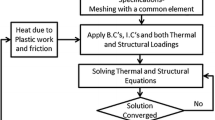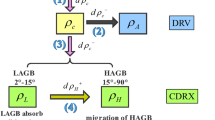Hot rolling, a critical step in the manufacturing of sheet products, influences the final sheet properties based on the microstructure evolution during this operation. A comprehensive mathematical model of the hot rolling process for aluminum alloys has been developed. This article outlines the development of a two-dimensional (2-D) mathematical model to simulate multipass hot rolling using the commercial finite element (FE) package, ABAQUS. Microstructure evolution during multipass rolling was modeled using a physically based approach to predict the stored energy and the resulting microstructure for an AA5083 aluminum alloy. The stored energy in the material between passes is quantified using a rule-of-mixtures approach based on the fraction of the material that is recrystallized. An extensive experimental program was undertaken to validate the model using Corus’ single-stand reversible rolling facility located in IJmuiden, The Netherlands. Overall, the model was able to simulate the thermomechanical history experienced during multipass hot rolling reasonably well based on comparison to temperature and rolling load measurements. The model was also able to predict the fraction recrystallized through the thickness of the strip reasonably well, but the grain size predictions were consistently low.













Similar content being viewed by others
Notes
ABAQUS is a trademark of ABAQUS, Inc., Providence, RI, USA.
Abbreviations
- d 0 :
-
initial grain size, μm
- d rex :
-
recrystallized grain size, μm
- t :
-
time, s
- \( \ifmmode\expandafter\dot\else\expandafter\.\fi{N} \) :
-
nucleation rate
- \( \ifmmode\expandafter\dot\else\expandafter\.\fi{G} \) :
-
growth rate
- Q :
-
activation energy, J mole−1
- n :
-
Avrami exponent
- T :
-
temperature °C, K
- X :
-
position along the length of the strip, mm
- Y :
-
position through the thickness of the strip, mm
- X v :
-
fraction transformed, pct
- ε :
-
strain
- \( \ifmmode\expandafter\dot\else\expandafter\.\fi{\varepsilon } \) :
-
strain rate, s−1
- R:
-
universal gas constant, J mole−1 °C−1
- σ f :
-
frictional stress, Pa
- ρ r :
-
random dislocation density, m−2
- ρ g :
-
geometrical necessary dislocation density, m−2
- ρ ι :
-
internal dislocation density, m−2
- μ :
-
coefficient of friction
- τ :
-
shear stress, Pa
- G :
-
shear modulus, Pa
- W :
-
temperature compensated time parameter, s
- δ :
-
average subgrain size, m
- θ :
-
average misorientation angle between subgrains, deg
- B :
-
burgers vector, m
- N v :
-
nucleation density, m−3
- N PSN :
-
particle-stimulated nucleation, m−3
- N C :
-
cube nucleation, m−3
- N GB :
-
grain boundary nucleation, m−3
- P D :
-
driving force, Pa
- S V :
-
grain boundary area per unit volume, μm−1
- δt :
-
time increment, s
- δε :
-
strain increment
- dθ :
-
misorientation angle between subgrains increment, deg
- dδ :
-
average subgrain size increment, μm
- dρ r :
-
random dislocation density increment, m−2
- d 1 :
-
grain length in the y direction, μm
- d 2 :
-
grain width in the x direction, μm
- Z :
-
Zener–Hollomon parameter, s−1
- Subscripts and superscripts :
-
- def:
-
deformation
- deformed:
-
deformed
- rex:
-
recrystallization
- roll:
-
roll
- entry:
-
entry
- strip:
-
strip
- interpass:
-
interpass
- ss :
-
steady state
- eff:
-
effective
- i :
-
current pass
- i–1:
-
previous pass
- r :
-
random
- G :
-
geometrical necessary
- C :
-
critical
- a :
-
annealing
- 0:
-
starting
References
H.E. Vatne, T. Furu, R. Orsund, E. Nes: Acta Mater., 1996, vol. 44, pp. 4463–73
X.J. Duan, T. Sheppard: Modell. Simul. Mater. Sci. Eng., 2002, vol. (10), pp. 363–80
H. Ahmed, M.A. Wells, D.M. Maijer, B.J. Howes, M.R. van der Winden: Mater. Sci. Eng. A, 2005, vol. 390 (1–2), pp. 278–90
H.E. Vatne, K. Marthinsen, R. Orsund, E. Nes: Metall. Mater. Trans. A, 1996, vol. 27A, pp. 4133–44
G.C. Reyes and J. Beynon: in Hot Deformation of Aluminum Alloys, TMS, Warrendale, PA, 1991.
K. Marthinsen, S. Abtahi, K. Sjolstad, B. Holmedal, E. Nes, A. Johansen, J.A. Saeter, T. Furu, O. Engler, Z.J. Lok, J. Talamantes-Silva, C. Allen, C. Liu: Aluminium, 2004, vol. 80 (6), pp. 729–38
T. Furu, K. Marthinsen, E. Nes: Mater. Sci. Technol., 1990, vol. 6, pp. 1093–1102
M.R. van der Winden: Ph.D. Thesis, Sheffield University, Sheffield, United Kingdom, 1999
M.A. Wells: Ph.D. Thesis, University of British Columbia, Vancouver, BC, Canada, 1995
VAI rolling technology report, private communication
VAI hot band technology report, private communication
X.J. Duan, T. Sheppard: Comput. Mater. Sci., 2003, vol. 27 (3), pp. 250–58
H.E. Vatne: Ph.D. Thesis, Norwegian Institute of Technology, Trondheim, Norway, 1995
H.E. Vatne, T. Furu, R. Orsund, E. Nes: Mater. Sci. Technol., 1996, vol. 12, pp. 201–10
J.P. Holman: Heat Transfer, McGraw-Hill, New York, NY, 1997.
M.A. Wells, D.M. Maijer, S. Jupp, G. Lockhart, M.R. van der Winden: Mater. Sci. Technol., 2003, vol. 19 (4), pp. 467–76
H. Ahmed, M.A. Wells, D.M. Maijer, M.R. van der Winden: in Hot Deformation of Aluminum Alloys III, TMS, Warrendale, PA, 2003
C.M. Sellars, Q. Zhu: Mater. Sci. Eng. A, 2000, vol. 280, pp. 1–7
C.M. Sellars and Q. Zhu: in Hot Deformation of Aluminum Alloys II, TMS, Warrendale, PA, 1998.
H. Ahmed: Ph.D. Thesis, University of British Columbia, Vancouver, BC, Canada, 2005
F.J. Humphreys, M. Hatherly: Recrystallization and Related Annealing Phenomena, Pergamon Press, New York, NY, 1996, p. 363
H. Ahmed, M.A. Wells, D.M. Maijer, M.R. van der Winden: Light Metals 2003, CIM, Vancouver, BC, Canada, 2003
Corus Research Development and Technology, Introduction to the Research Mill of Corus Research Development and Technology, 2000
C.D. Henning and R. Parker: J. Heat Transfer, 1967, pp. 146–54
K.D. Maglic, B.S. Marsicanin: High Temp.-High Press., 1973, vol. 5, pp. 105–10
S.P. Timothy, H.L. Yiu, J.M. Fine, R.A. Ricks: Mater. Sci. Technol., 1991, vol. 7 (3), pp. 255–61
Acknowledgments
The authors are grateful to Corus for funding this research project as well as providing access to their experimental rolling mill. The useful discussions with Drs. C. Liu and A. Norman and the technical help of Messrs. J. Wörmann and J. Brussel, Corus RD&T, are gratefully acknowledged. The financial support of the Natural Sciences and Engineering Research Council of Canada (NSERC) in the form of a graduate scholarship is gratefully acknowledged.
Author information
Authors and Affiliations
Corresponding author
Additional information
Manuscript submitted October 11, 2005.
Rights and permissions
About this article
Cite this article
Ahmed, H., Wells, M., Maijer, D. et al. Mathematical Modeling of Multipass Hot Deformation of Aluminum Alloy AA5083—Model Development and Validation. Metall Mater Trans A 38, 922–935 (2007). https://doi.org/10.1007/s11661-007-9101-1
Published:
Issue Date:
DOI: https://doi.org/10.1007/s11661-007-9101-1




